MXA’S 2013 KTM 65SXS MOTOCROSS TEST: LOOKING FOR A LOOPHOLE IN THE 65 RULES? HERE IT IS
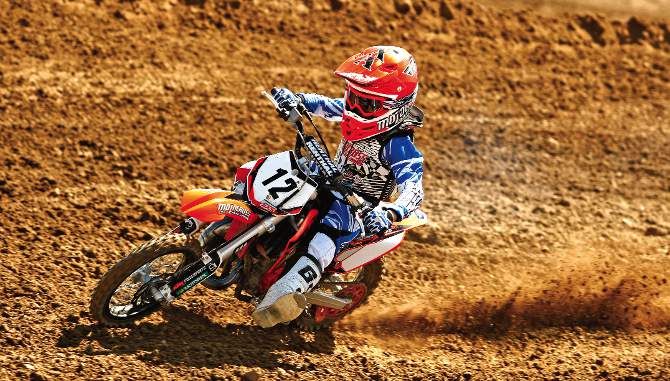
FIRST AND FOREMOST, WHAT EXACTLY IS AN “SXS”?
A: KTM’s SXS program essentially takes advantage of a loophole in the AMA Amateur rulebook, which reads, under Section 1.2, article A, part B, “For a minicycle to be homologated, the manufacturer must apply to the AMA, register the machine’s specifications, provide photographs, an OEM parts list and provide that up to 100 identical machines of the same year and model are available for sale to the general public through a distributor network.” KTM’s SXS program, which began in 2011 with the 50SXS, specifically targets Amateur racers looking for a mechanical advantage over their competition. Racing an SXS bike isn’t cheating, because KTM has done their homework to ensure that each model has passed the AMA’s homologation standards. If the SXS program sounds eerily familiar, look no further than KTM’s 450SXF “Factory Edition” bike (also known as the “Ryan Dungey Replica”). The Austrians aren’t new to this game.
KTM realized that Amateur racers yearned for aftermarket components on their bikes, but couldn’t get them because the AMA forbade such changes. So, KTM ingeniously added these desirable components to their production bikes. They built the required number of bikes to pass homologation, labeled them “SXS”, and priced them higher than the standard SX line. As a result, these special-edition models sold like hot cakes. You’ll be hard-pressed to find a 2013 KTM 65SXS on a showroom floor, but fear not, the 2014 50SXS, 65SXS and 85SXS are coming down the pipeline soon.
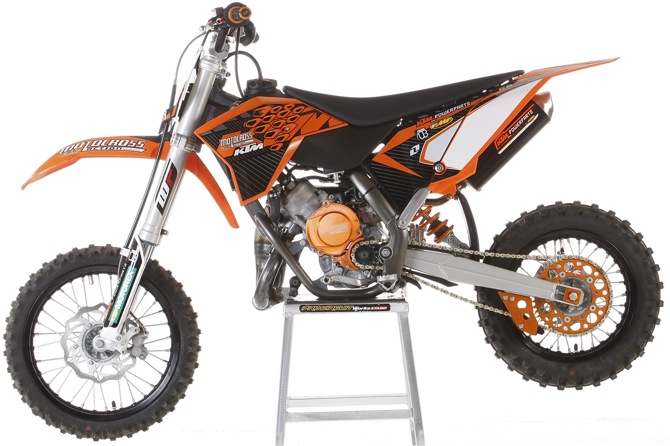
Q: WHAT ARE THE DIFFERENCES BETWEEN THE STOCK 65SX AND THE 65SXS?
A: The KTM factory in Austria listened to consumer demand and outfitted the 65SXS with a variety of performance and cosmetic upgrades. Improvements can be found in the engine and carburetor, with a focus on durability and aesthetics. The changes are listed below.
(1) Engine. KTM spec’ed a performance cylinder that is claimed to drastically improve horsepower. Keep in mind that a 65cc two-stroke peaks at 16 horsepower. Adding more punch to a pint-sized powerband is a huge advantage on the battlefield.
(2) Exhaust. FMF has teamed up with KTM’s expansive PowerParts division to offer a variety of exhaust systems for two- and four-strokes. The 65SXS comes equipped with an FMF pipe and silencer labeled as a KTM PowerParts item.
(3) Carburetor. While the 65SXS uses the stock Mikuni carb, the settings have been revised to complement the engine and exhaust changes.
(4) Billet parts. Orange anodized hard parts litter the 65SXS. The chain guide, case guard, chain adjuster blocks and ignition cover are made from billet aluminum. The ignition cover can be laser-etched with the rider’s name and number.
(5) Add-ons. The 65SXS comes with several other unique features that make it stand out from a stock 65SX. These items include a PowerParts holeshot device, 47-tooth Renthal orange rear sprocket and an SXS special-edition graphics kit (with sublimated shroud decals).

KTM?65SXS: Consider the 65SXS to be the “Ryan Dungey Replica” of the elementary school set. It is a limited-edition model designed to meet all NMA and AMA Stock class rules. It is a step above the basic 65SX.
Q: CAN THE 2013 KTM 65SXS BE RACED IN THE STOCK CLASS?
A: Yes! This is the most attractive feature of the 65SXS. Amateur Stock-class racing is closely policed by trolling parents looking to blow the whistle on their kids’ competition. Countless stories abound of riders making slight, inconsequential modifications to their bikes only to be disqualified. KTM has done a masterful job of providing a legal way to bend the rules and thus stop the finger-pointing.
What parts cannot be changed or modified for a bike to be eligible in the Stock class? The airbox, carburetor (although jetting changes are allowed), electronics, frame, rim size, stroke, swingarm, wheel hubs, lower triple clamps, internal engine components and the exhaust system are off limits. The 2013 KTM 65SXS has a different exhaust system and cylinder from the 65SX?two very critical areas of improvement (more on that below).

Q: HOW MUCH DOES THE 2013 KTM 65SXS RETAIL FOR?
A: $5299. It is the most expensive 65cc two-stroke in its class?$800 more than the standard KTM 65SX. Considering that the 65SXS comes chock-full of hop-up parts and is eligible for the Stock class, however, it is worth the investment. A lot of mini parents will bite the bullet and spend the extra dough.
As for the other 65cc bikes in the class, the 2013 Cobra CX65 retails for $4748 (read the test of the CX65 in the June issue), and the Kawasaki KX65 is $3649 but desperately needs updates to compete against the KTM and Cobra bikes.
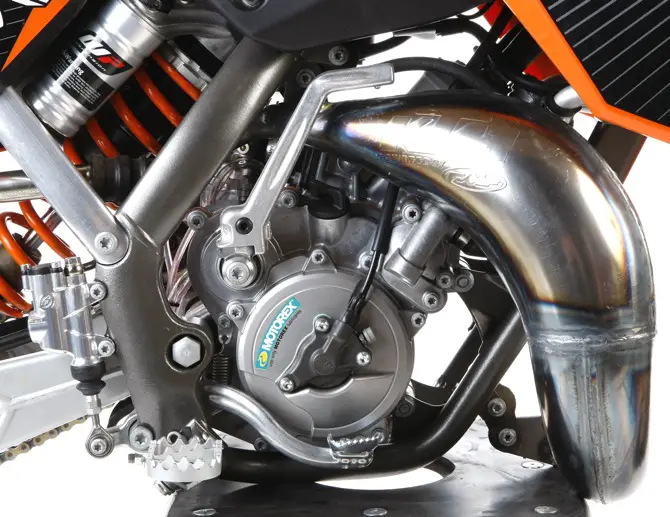
Pump me up: To pump out extra power, the 65SXS gets a ported cylinder, revised jetting and an FMF exhaust.
Q: HOW MANY 65SXS BIKES DOES KTM MAKE?
A: According to KTM, they only make the minimum necessary to satisfy the homologation criteria. We surmise that KTM stopped the assembly line after producing around 120 KTM 65SXS bikes. This model is only available for sale in North America, although the 65SXS is assembled in Austria and shipped over to the U.S. While the standard production 65SX is released around June, the SXS version trickles into select dealerships around November. A tip for prospective SXS owners: act quickly if you intend to buy a 65SXS, because they will sell out in no time.
Q: HOW FAST IS THE 2013 KTM 65SXS?
A: In the hands of a competent, speed-hungry youngster, the 65SXS is a rocket. If you’re looking for a bike to compete at the Amateur Nationals in the Stock class, the KTM 65SXS had better be on your short list. Compared to the 65SX, the SXS has a smoother, more usable powerband with greater top-end speed. The 65SX pumps out around 16 ponies, while the 65SXS makes an additional 3-1/2 horsepower with the ported cylinder and FMF exhaust system.
Is the 2013 KTM 65SXS faster than the Cobra CX65? Advanced testers felt that the CX65 with the electronic power valve (a first in its class) had the stronger powerplant; however, less skilled riders appreciated the metered and consistent feel of the KTM powerband. Unlike the CX65 engine, which kicked like an Army Mule when the power valve opened up, the 65SXS was manageable. Pick your kid’s poison.
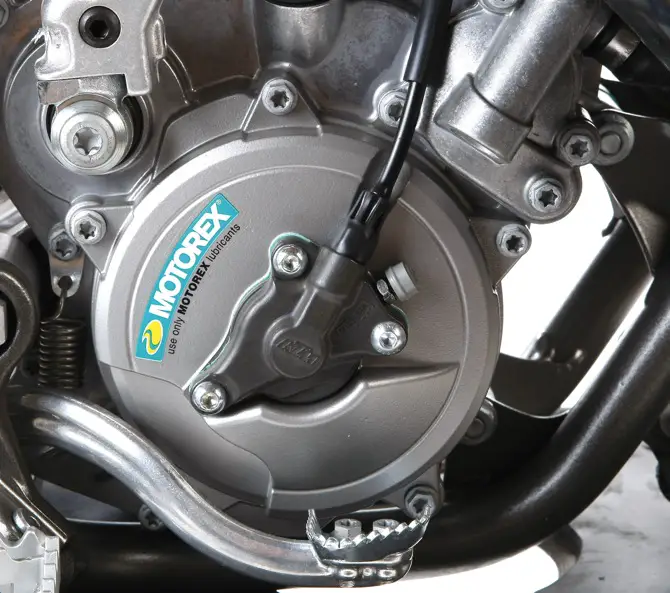
Q: HOW DOES THE KTM 65SXS HANDLE?
A: KTM believes that chromoly steel frames are superior to aluminum frames. We can’t fault the Austrians’ logic, and we admire their courage. Even though aluminum typically wins out in the court of public opinion, KTM has stuck to its guns. They should be applauded for their efforts to build balanced bikes that handle well. The 65SXS feels balanced fore to aft, and MXA test riders complimented the cornering traits of the SXS. Unfortunately, the suspension left a lot to be desired, which hampered the handling in certain situations. More on that below.
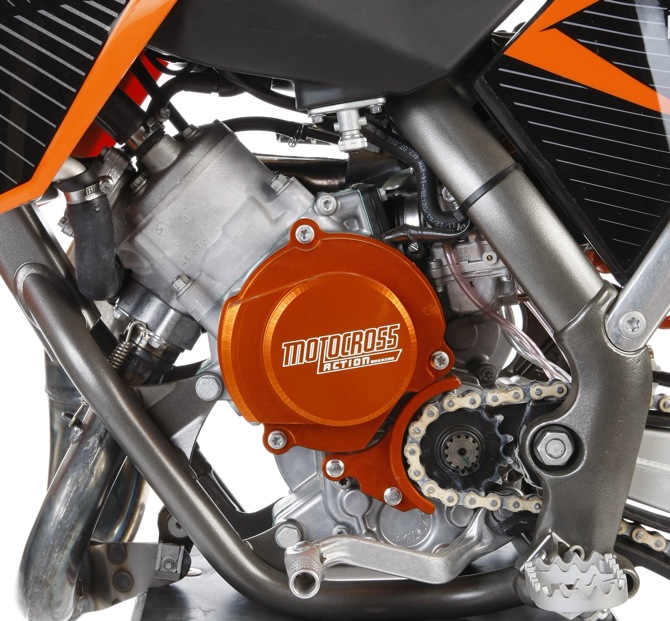
Personalization: Every KTM?65SXS rider gets his name or number engraved on the anodized ignition cover. It is a nice touch on a limited-edition machine.
Q: WHAT DO WE THINK ABOUT THE WP SUSPENSION?
A: You shouldn’t be surprised that KTM switched from Marzocchi to WP forks in 2012. Why? KTM owns WP. The saying, “Why buy the cow when you can get the milk for free?” has never been more appropriate. Unfortunately, the WP suspension setup is too aggressive for most riders. We understand KTM’s dilemma. It’s not easy to spec the 65SXS with spring rates and an oil height that work for everyone. KTM is trying to hit a moving target, aiming at riders from 6 to 11 years old who could weigh anywhere from 40 to 80 pounds.
Smaller riders complained that the spring rates were too stiff for them to reap the benefits of the suspension’s full travel. They found the shock spring especially stiff. So, while the 65SXS felt balanced, the suspension was problematic for most younger riders.

Q: WHAT DO WE HATE?
A: The hate list:
(1) Gas cap. KTM abolished the terrible push-and-turn gas cap on their big bikes but kept it on the 65SXS. Perhaps KTM wanted to make sure that kids couldn’t access the gas tank. Cut off the tangs to avoid aggravation.
(2) Side panels. What side panels? We didn’t put numbers on the side panels because there wasn’t any room.
(3) Suspension. Your child will have trouble with the spring rates if he is a featherweight.
(4) Front number plate. KTM lists the 65SXS upgrades on a preprinted front number plate. That’s great for the showroom floor, but it makes no sense once you get the bike home. We cut out the center area with an X-acto knife.
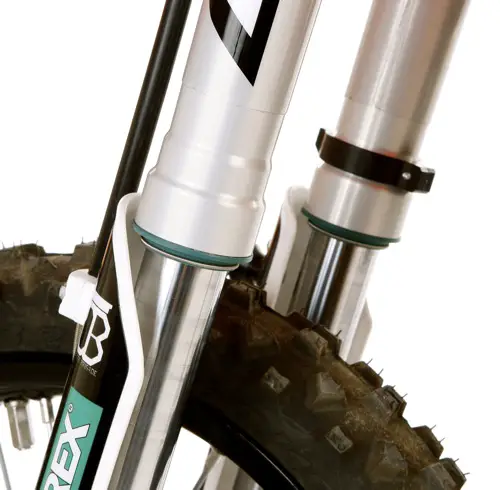
Spring to action: Most small or slow test riders felt that the WP forks were too stiff, but the slightly older, larger and faster riders were happy.
Q: WHAT DO WE LIKE?
A: The like list:
(1) Engine. The 65SXS powerplant is extremely fast but not too overwhelming for young riders. It’s baby bear’s porridge.
(2) Front brake. Some riders thought it was too sensitive, but once they got used to it, they appreciated the extra pucker power.
(3) Clutch. The Magura hydraulic clutch can take a licking and keep on ticking?an important feature since most kids are clutch abusers.
(4) Stock class. KTM hit a home run by pumping up the 65SX’s powerband and durability, labeling it a 65SXS, and homologating it for the Stock class. Brilliant!
(5) Appearance. The 65SXS looks like a miniature KTM 125SX. Eat your heart out, Wayne Szalinski.
Q: WHAT DO WE REALLY THINK?
A: We applaud KTM’s creative strategy to build a bike that skirts the AMA rulebook while appealing to serious Amateur racers. Is it an unfair advantage? We don’t think so. KTM had to invent the aftermarket-as-stock concept to compete against its chief rival, Cobra motorcycles. We foresee that the battle for mini-bike supremacy will advance long-dormant technology?and obviously raise the cost of racing the Stock class. We’ve seen this scenario play out before, and we have some legitimate concerns. But, as long as manufacturers like KTM and Cobra don’t price families out of riding dirt bikes, we’re all for it.





Comments are closed.